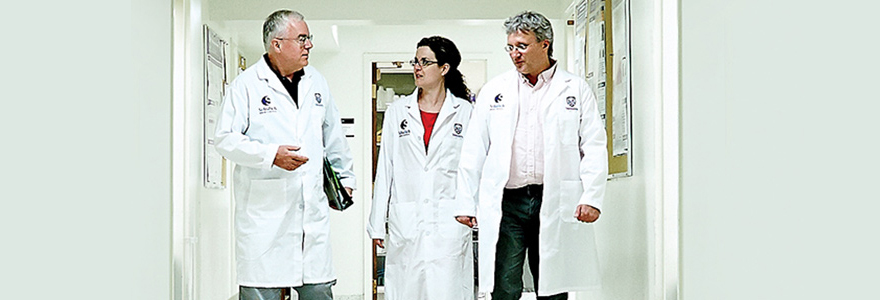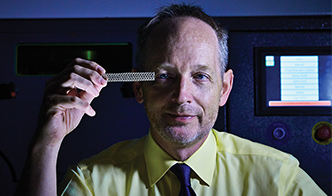Strength in numbers

Musculoskeletal diseases are a massive economic and health burden to Canadians and people across the world. Researchers at Schulich Medicine & Dentistry are teaming up to solve the mysteries behind endemic diseases that are eroding the foundation of the human body
By Tristan Joseph, BA’98
It’s 2040. A 62-year-old man walks into his doctor’s office with severe knee pain and stiffness. He remembers his own father being diagnosed with osteoarthritis. He was by his father’s side through knee replacement surgery and months of rehabilitation followed by the constant presence and need for a walker. Medicine has changed, however, and his doctor tells him the good news. There’s an effective treatment for his condition—one that will have him back to normal in a few weeks. The treatment was developed as a result of research conducted by the Western Cluster of Research Excellence in Musculoskeletal Health (MSK Cluster).
This is the dream that drives David Holdsworth, PhD, the director of the MSK Cluster.
Musculoskeletal diseases affect 11 million Canadians, 12 years of age and older each year. It doesn’t discriminate, from the 17-year-old soccer player who injures her anterior cruciate ligament to the 52-year-old construction worker who has a workplace accident—millions are affected.
By 2031, that number[1] will rise to 15 million. With $22.3 billion of direct and indirect costs to the economy and an aging population, musculoskeletal diseases impact every single Canadian.
“The reality in Canada is that people are living longer with the expectation that they will be able to continue to travel, try new activities and live at home independently,” said Holdsworth. “That life is only possible with continued mobility.”
The goal of the MSK Cluster is to provide life-long mobility for people across the globe, reducing the burden to the economy and health-care system.
The MSK Cluster is a transdisciplinary achievement, providing researchers with the ability to cross traditional boundaries. For Holdsworth, the strength of the grassroots initiative comes from crossing faculty and departmental lines in Health Science, Engineering, Social Science, Science and the Schulich School of Medicine & Dentistry.
 Holdsworth works with a team of more than 70 researchers who form the MSK Cluster. It adds to his roles as Professor in Medical Biophysics, and Surgery, the Dr. Sandy Kirkley Chair in Musculoskeletal Research, and scientist at Robarts Research Institute.
Holdsworth works with a team of more than 70 researchers who form the MSK Cluster. It adds to his roles as Professor in Medical Biophysics, and Surgery, the Dr. Sandy Kirkley Chair in Musculoskeletal Research, and scientist at Robarts Research Institute.
The team at Schulich Medicine & Dentistry includes Dr. Jeff Dixon, DDS’77, PhD; Cheryle Séguin, MSc’01, PhD; and Frank Beier, PhD, in addition to 43 other researchers.
“The reality in Canada is that people are living longer with the expectation that they will be able to continue to travel, try new activities and live at home independently. That life is only possible with continued mobility.” —David Holdsworth
Making a Global Impact
In the 1980s, Dr. Dixon left his dental practice to study bone and cell biology. He found a home at Schulich Medicine & Dentistry as a professor in Physiology and Pharmacology, and Dentistry. Today, he also serves as the chair of the MSK Cluster Operating Committee and was honoured with a Distinguished University Professorship in 2015. His work focuses on the cellular and molecular mechanisms underlying the formation and destruction of bone and cartilage. Dr. Dixon describes his work as a detective mystery. Each day at the lab gets his team closer to the answers behind diseases like osteoporosis, periodontitis and osteoarthritis.
Working within the MSK Cluster has expanded his focus. His research encompasses working with Séguin on spine disease, with Holdsworth and Stephen Sims, BSc’75, PhD, on imaging bone cells and investigating therapies that could slow down bone loss or restore bone density.
“This is the way that I and the whole MSK Cluster can make a meaningful impact in Canada and the world in terms of improving musculoskeletal health,” said Dr. Dixon. “Gone are the days of having your own lab and focusing on one thing,” said Séguin. “Science is now focused on teams of scientists working together to tackle many different problems. The MSK Cluster better prepares our trainees to walk into that environment.”
Teaching the Team Approach
Working within the MSK Cluster has expanded the possibilities for Séguin’s research. She is focused on understanding the factors behind the development of intervertebral discs—the soft, connective tissue joints of the spine that keep the back stable and enable movement.
“You can be stuck on a problem and immediately access experts who have the solution,” said Séguin. “That team approach, that unique and open collaborative environment, exists because you’re drawing on such diverse expertise.”
Séguin is an associate professor in Physiology and Pharmacology and co-director of the Collaborative Training Program in Musculoskeletal Health Research, where she educates the next generation of researchers.
Aging Well
Beier wears many hats across Schulich Medicine & Dentistry. He is a professor of Physiology and Pharmacology, mentor extraordinaire in the Collaborative Training Program, and holds a Canada Research Chair in Musculoskeletal Research. With the creation of the MSK Cluster, he has taken on a new role as a member of the MSK Operating Committee.
Beier studies the biology of cartilage during skeletal development and the progression of osteoarthritis. Utilizing genetic, molecular and cell biological approaches, the Beier Lab has demonstrated significant links between cartilage development and osteoarthritis.
He sees the importance of the MSK Cluster in its long-term impact. “Most musculoskeletal conditions, such as osteoarthritis, are not a normal fact of aging,” said Beier. “People shouldn’t be living the last 20 to 30 years of their lives unable to walk. Musculoskeletal diseases are something that we should be able to treat.”
Solving the Mystery Behind Musculoskeletal Diseases
A tour of Robarts Research Institute with Holdsworth will inevitably take you to a room that houses the only 3-D printer in Canada capable of printing in metal, such as stainless steel and medical-grade alloys. The room also houses a variety of metal toy cats, cylinders and two joint-shaped parts—one solid and one made of a stainless steel mesh. The question behind the mesh is whether artificial joint implants with holes will integrate better inside the body and result in a better outcome for the patient. With the help of basic scientists, clinicians and imaging scientists, the MSK Cluster hopes to answer that question and hundreds more.
The strength of the MSK Cluster is its people—a community of researchers who are building a solid national and international foundation for research that will change the face of disability in the coming decades.








